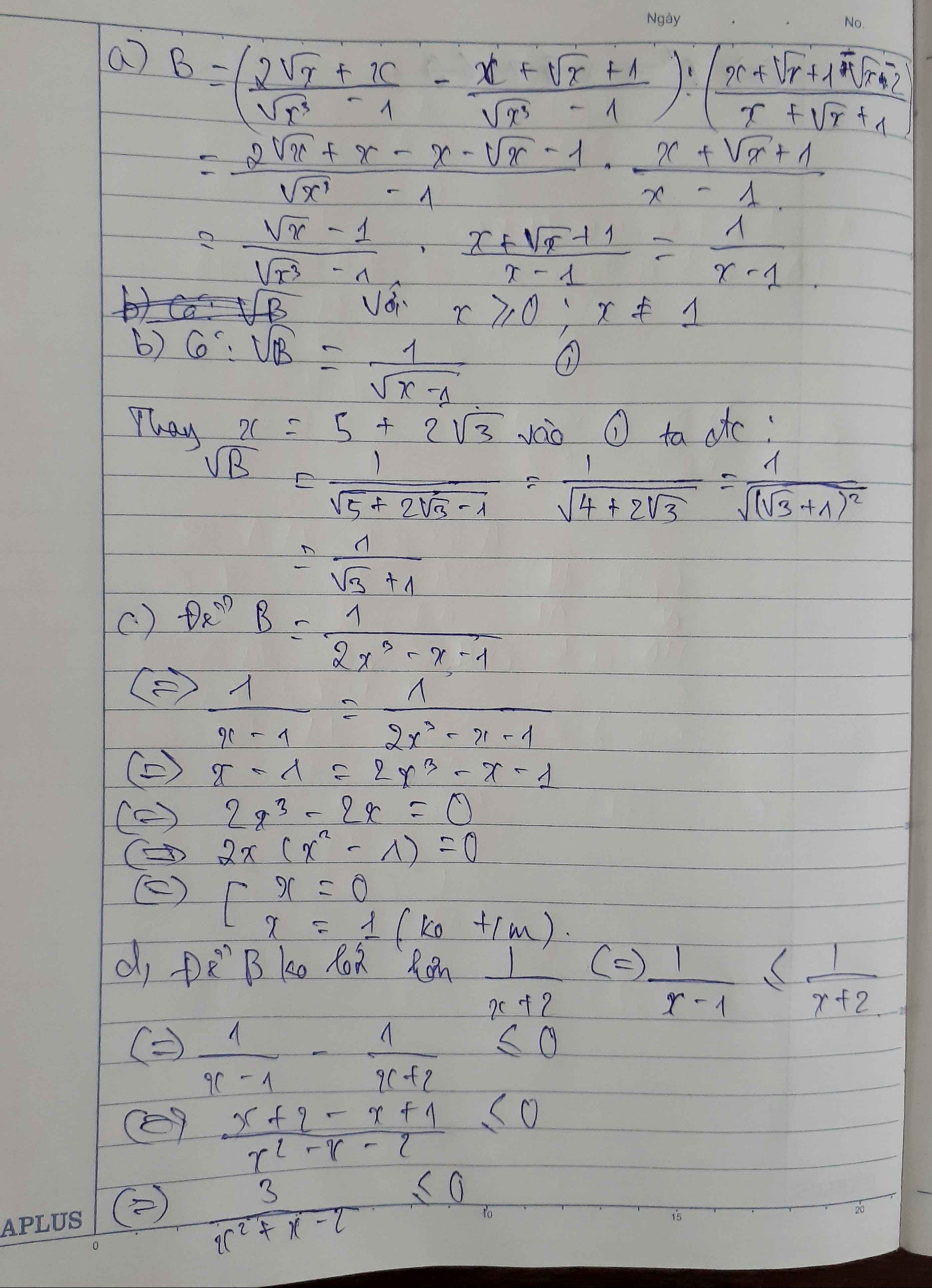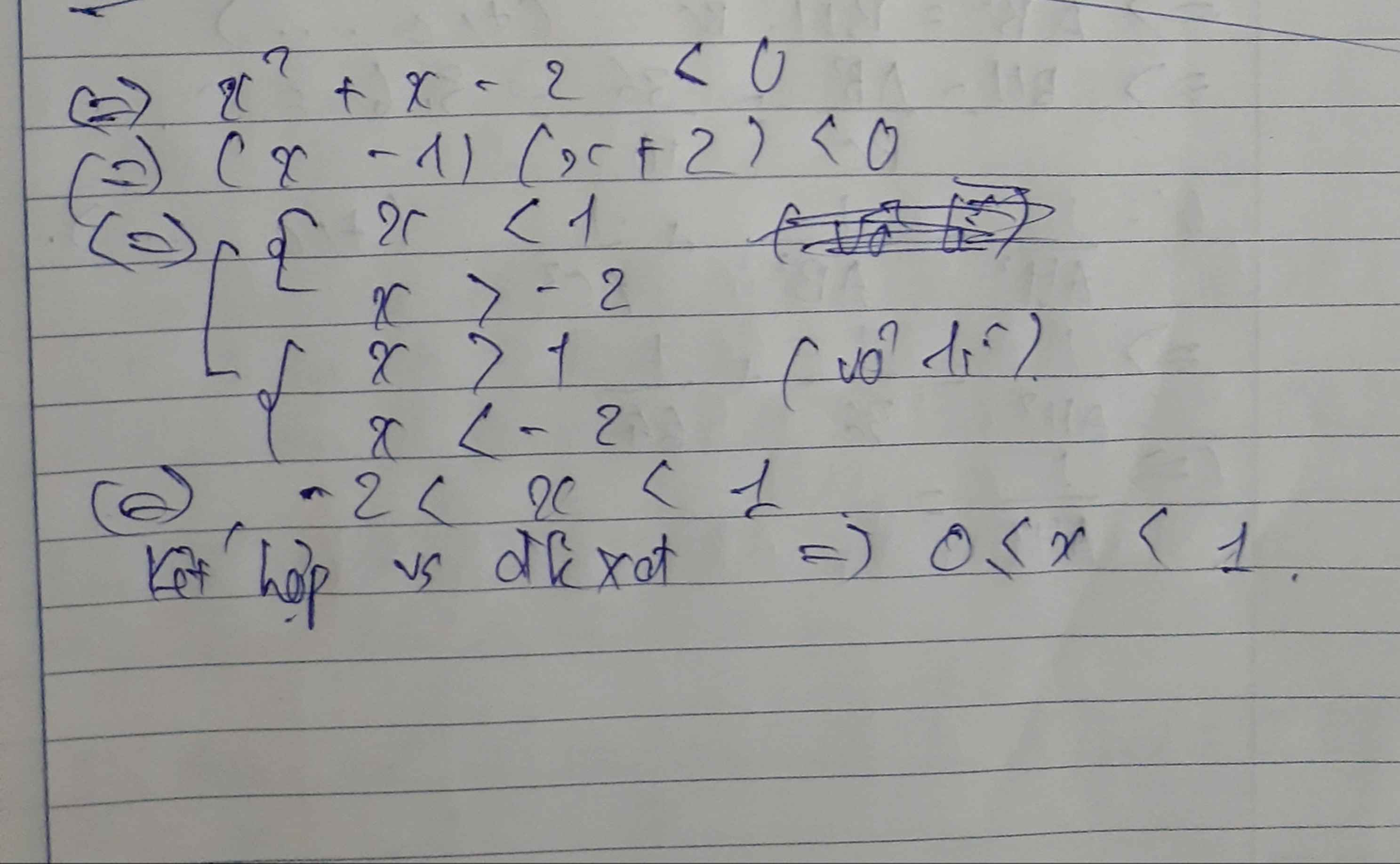Hãy nhập câu hỏi của bạn vào đây, nếu là tài khoản VIP, bạn sẽ được ưu tiên trả lời.

a) ĐKXĐ: \(\left\{{}\begin{matrix}x>0\\x\ne4\end{matrix}\right.\)
b) Ta có: \(A=\left(\dfrac{\sqrt{x}}{\sqrt{x}-2}-\dfrac{4}{x-2\sqrt{x}}\right)\left(\dfrac{1}{\sqrt{x}+2}+\dfrac{4}{x-4}\right)\)
\(=\dfrac{x-4}{\sqrt{x}\left(\sqrt{x}-2\right)}\cdot\dfrac{\sqrt{x}-2+4}{\left(\sqrt{x}+2\right)\left(\sqrt{x}-2\right)}\)
\(=\dfrac{\sqrt{x}+2}{\sqrt{x}\left(\sqrt{x}-2\right)}\)
d) Để A>0 thì \(\sqrt{x}-2>0\)
hay x>4

a: ĐKXĐ: \(\left\{{}\begin{matrix}x\ge0\\x\ne1\end{matrix}\right.\)
Ta có: \(A=\dfrac{\sqrt{x}}{\sqrt{x}-1}+\dfrac{3}{\sqrt{x}+1}-\dfrac{6\sqrt{x}-4}{x-1}\)
\(=\dfrac{x+\sqrt{x}+3\sqrt{x}-3-6\sqrt{x}+4}{\left(\sqrt{x}-1\right)\left(\sqrt{x}+1\right)}\)
\(=\dfrac{\sqrt{x}-1}{\sqrt{x}+1}\)
Thay \(x=6-2\sqrt{5}\) vào A, ta được:
\(A=\dfrac{\sqrt{5}-1-1}{\sqrt{5}-1+1}=\dfrac{\sqrt{5}-2}{\sqrt{5}}=\dfrac{5-2\sqrt{5}}{5}\)
b: Để \(A< \dfrac{1}{2}\) thì \(\dfrac{\sqrt{x}-1}{\sqrt{x}+1}-\dfrac{1}{2}< 0\)
\(\Leftrightarrow2\sqrt{x}-2-\sqrt{x}-1< 0\)
\(\Leftrightarrow x< 9\)
Kết hợp ĐKXĐ, ta được: \(\left\{{}\begin{matrix}0\le x< 9\\x\ne1\end{matrix}\right.\)

a) Ta có: \(P=\dfrac{3x+\sqrt{9x}-3}{x+\sqrt{x}-2}-\dfrac{\sqrt{x}+1}{\sqrt{x}+2}+\dfrac{\sqrt{x}-2}{1-\sqrt{x}}\)
\(=\dfrac{3x+3\sqrt{x}-3-x+1-x+4}{\left(\sqrt{x}+2\right)\left(\sqrt{x}-1\right)}\)
\(=\dfrac{x+3\sqrt{x}+2}{\left(\sqrt{x}+2\right)\left(\sqrt{x}-1\right)}\)
\(=\dfrac{\sqrt{x}+1}{\sqrt{x}-1}\)

a) \(B=\left(\dfrac{2\sqrt{x}+x}{x\sqrt{x}-1}-\dfrac{1}{\sqrt{x}-1}\right):\left(1-\dfrac{\sqrt{x}+2}{x+\sqrt{x}+1}\right)\left(x\ge0,x\ne1\right)\)
\(=\left(\dfrac{2\sqrt{x}+x}{\left(\sqrt{x}-1\right)\left(x+\sqrt{x}+1\right)}-\dfrac{1}{\sqrt{x}-1}\right):\dfrac{x+\sqrt{x}+1-\sqrt{x}-2}{x+\sqrt{x}+1}\)
\(=\dfrac{2\sqrt{x}+x-x-\sqrt{x}-1}{\left(\sqrt{x}-1\right)\left(x+\sqrt{x}+1\right)}:\dfrac{x-1}{x+\sqrt{x}+1}\)
\(=\dfrac{\sqrt{x}-1}{\left(\sqrt{x}-1\right)\left(x+\sqrt{x}+1\right)}.\dfrac{x+\sqrt{x}+1}{x-1}=\dfrac{1}{x-1}\)

Sửa đề: \(P=\left(\dfrac{1}{x-\sqrt{x}}+\dfrac{1}{\sqrt{x}-1}\right):\dfrac{\sqrt{x}}{x-2\sqrt{x}+1}\)
a) Ta có: \(P=\left(\dfrac{1}{x-\sqrt{x}}+\dfrac{1}{\sqrt{x}-1}\right):\dfrac{\sqrt{x}}{x-2\sqrt{x}+1}\)
\(=\left(\dfrac{1}{\sqrt{x}\left(\sqrt{x}-1\right)}+\dfrac{\sqrt{x}}{\sqrt{x}\left(\sqrt{x}-1\right)}\right):\dfrac{\sqrt{x}}{\left(\sqrt{x}-1\right)^2}\)
\(=\dfrac{\sqrt{x}+1}{\sqrt{x}\left(\sqrt{x}-1\right)}\cdot\dfrac{\left(\sqrt{x}-1\right)^2}{\sqrt{x}}\)
\(=\dfrac{x-1}{x}\)
b) Sửa đề: \(2\sqrt{x+1}=5\)
Ta có: \(2\sqrt{x+1}=5\)
\(\Leftrightarrow\sqrt{x+1}=\dfrac{5}{2}\)
\(\Leftrightarrow x+1=\dfrac{25}{4}\)
hay \(x=\dfrac{21}{4}\)(thỏa ĐK)
Thay \(x=\dfrac{21}{4}\) vào biểu thức \(P=\dfrac{x-1}{x}\), ta được:
\(P=\left(\dfrac{21}{4}-1\right):\dfrac{21}{4}=\dfrac{17}{4}\cdot\dfrac{4}{21}=\dfrac{17}{21}\)
Vậy: Khi \(2\sqrt{x+1}=5\) thì \(P=\dfrac{17}{21}\)
c) Để \(P>\dfrac{1}{2}\) thì \(P-\dfrac{1}{2}>0\)
\(\Leftrightarrow\dfrac{x-1}{x}-\dfrac{1}{2}>0\)
\(\Leftrightarrow\dfrac{2\left(x-1\right)}{2x}-\dfrac{x-1}{2x}>0\)
mà \(2x>0\forall x\) thỏa mãn ĐKXĐ
nen \(2\left(x-1\right)-x+1>0\)
\(\Leftrightarrow2x-2-x+1>0\)
\(\Leftrightarrow x-1>0\)
hay x>1
Kết hợp ĐKXĐ, ta được: x>1
Vậy: Để \(P>\dfrac{1}{2}\) thì x>1

a) \(P=\dfrac{4\sqrt{x}\left(2-\sqrt{x}\right)+8x}{\left(2+\sqrt{x}\right)\left(2-\sqrt{x}\right)}:\dfrac{\left(\sqrt{x}-1\right)-2\left(\sqrt{x}-2\right)}{\sqrt{x}\left(\sqrt{x}-2\right)}\\ =\dfrac{8\sqrt{x}+4x}{\left(2+\sqrt{x}\right)\left(2-\sqrt{x}\right)}:\dfrac{3-\sqrt{x}}{\sqrt{x}\left(\sqrt{x}-2\right)}\\ =\dfrac{8\sqrt{x}+4x}{\left(2+\sqrt{x}\right)\left(2-\sqrt{x}\right)}.\dfrac{\sqrt{x}\left(\sqrt{x}-2\right)}{3-\sqrt{x}}=\dfrac{4x}{\sqrt{x}-3}\)
\(\left(x\ge0;x\ne4;9\right)\)
b)\(P=-1\Leftrightarrow4x+\sqrt{x}-3=0\Leftrightarrow\sqrt{x}=\dfrac{3}{4}\Leftrightarrow x=\dfrac{9}{16}\)
c) bpt đưa về dạng \(4mx>x+1\Leftrightarrow\left(4x-1\right)x>1\)
Nếu \(4m-1\le0\) thì tập nghiệm không thể chứa mọi giá trị \(x>9\); Nếu \(4m-1>0\) thì tập nghiệm bpt là \(x>\dfrac{1}{4m-1}\). Do đó bpt tm mọi \(x>9\Leftrightarrow9\ge\dfrac{1}{4m-1}\) và \(4m-1>0\). ta có \(m\ge\dfrac{5}{18}\)

Câu 1:
ĐKXĐ: \(\left\{{}\begin{matrix}x\ge0\\x\ne9\end{matrix}\right.\)
a) Thay x=16 vào B, ta được:
\(B=\dfrac{1}{\sqrt{16}-3}=\dfrac{1}{4-3}=1\)
Vậy: Khi x=16 thì B=1
b) Ta có: M=A-B
\(=\dfrac{x+3}{x-9}+\dfrac{2}{\sqrt{x}+3}-\dfrac{1}{\sqrt{x}-3}\)
\(=\dfrac{x+3}{\left(\sqrt{x}-3\right)\left(\sqrt{x}+3\right)}+\dfrac{2\left(\sqrt{x}-3\right)}{\left(\sqrt{x}+3\right)\left(\sqrt{x}-3\right)}-\dfrac{\sqrt{x}+3}{\left(\sqrt{x}-3\right)\left(\sqrt{x}+3\right)}\)
\(=\dfrac{x+3+2\sqrt{x}-6-\sqrt{x}-3}{\left(\sqrt{x}+3\right)\left(\sqrt{x}-3\right)}\)
\(=\dfrac{x+\sqrt{x}-6}{\left(\sqrt{x}+3\right)\left(\sqrt{x}-3\right)}\)
\(=\dfrac{x+3\sqrt{x}-2\sqrt{x}-6}{\left(\sqrt{x}+3\right)\left(\sqrt{x}-3\right)}\)
\(=\dfrac{\sqrt{x}\left(\sqrt{x}+3\right)-2\left(\sqrt{x}+3\right)}{\left(\sqrt{x}+3\right)\left(\sqrt{x}-3\right)}\)
\(=\dfrac{\left(\sqrt{x}+3\right)\left(\sqrt{x}-2\right)}{\left(\sqrt{x}+3\right)\left(\sqrt{x}-3\right)}\)
\(=\dfrac{\sqrt{x}-2}{\sqrt{x}-3}\)
c) Để \(M=\dfrac{\sqrt{x}+1}{\sqrt{x}+2}\) thì \(\dfrac{\sqrt{x}-2}{\sqrt{x}-3}=\dfrac{\sqrt{x}+1}{\sqrt{x}+2}\)
\(\Leftrightarrow\left(\sqrt{x}-2\right)\left(\sqrt{x}+2\right)=\left(\sqrt{x}-3\right)\left(\sqrt{x}+1\right)\)
\(\Leftrightarrow x-4=x-2\sqrt{x}-3\)
\(\Leftrightarrow-2\sqrt{x}-3=-4\)
\(\Leftrightarrow-2\sqrt{x}=-1\)
\(\Leftrightarrow\sqrt{x}=\dfrac{1}{2}\)
hay \(x=\dfrac{1}{4}\)(thỏa ĐK)
Vậy: Để \(M=\dfrac{\sqrt{x}+1}{\sqrt{x}+2}\) thì \(x=\dfrac{1}{4}\)
Câu 2:
b) Gọi thời gian tổ 1 hoàn thành công việc khi làm một mình là x(giờ)
thời gian tổ 2 hoàn thành công việc khi làm một mình là y(giờ)
(Điều kiện: x>12; y>12)
Trong 1 giờ, tổ 1 làm được: \(\dfrac{1}{x}\)(công việc)
Trong 1 giờ, tổ 2 làm được: \(\dfrac{1}{y}\)(công việc)
Trong 1 giờ, hai tổ làm được: \(\dfrac{1}{12}\)(công việc)
Do đó, ta có phương trình: \(\dfrac{1}{x}+\dfrac{1}{y}=\dfrac{1}{12}\)(1)
Vì khi tổ 1 làm trong 2 giờ, tổ 2 làm trong 7 giờ thì hai tổ hoàn thành được một nửa công việc nên ta có phương trình: \(\dfrac{2}{x}+\dfrac{7}{y}=\dfrac{1}{2}\)(2)
Từ (1) và (2) ta lập được hệ phương trình:
\(\left\{{}\begin{matrix}\dfrac{1}{x}+\dfrac{1}{y}=\dfrac{1}{12}\\\dfrac{2}{x}+\dfrac{7}{y}=\dfrac{1}{2}\end{matrix}\right.\Leftrightarrow\left\{{}\begin{matrix}\dfrac{2}{x}+\dfrac{2}{y}=\dfrac{1}{6}\\\dfrac{2}{x}+\dfrac{7}{y}=\dfrac{1}{2}\end{matrix}\right.\)
\(\Leftrightarrow\left\{{}\begin{matrix}\dfrac{-5}{y}=\dfrac{-1}{3}\\\dfrac{1}{x}+\dfrac{1}{y}=\dfrac{1}{12}\end{matrix}\right.\Leftrightarrow\left\{{}\begin{matrix}y=15\\\dfrac{1}{x}+\dfrac{1}{15}=\dfrac{1}{12}\end{matrix}\right.\)
\(\Leftrightarrow\left\{{}\begin{matrix}\dfrac{1}{x}=\dfrac{1}{60}\\y=15\end{matrix}\right.\Leftrightarrow\left\{{}\begin{matrix}x=60\\y=15\end{matrix}\right.\)(thỏa ĐK)
Vậy: Tổ 1 cần 60 giờ để hoàn thành công việc khi làm một mình
Tổ 2 cần 15 giờ để hoàn thành công việc khi làm một mình



Câu 3
a, ĐKXĐ: x>0, x\(\ne\)4
M=( \(\dfrac{\sqrt{x}}{\sqrt{x}-2}+\dfrac{\sqrt{x}}{\sqrt{x}+2}\)). \(\dfrac{\sqrt{x}+2}{\sqrt{4x}}\)
M= \(\left(\dfrac{\sqrt{x}\left(\sqrt{x}+2\right)}{\left(\sqrt{x}-2\right)\left(\sqrt{x}+2\right)}+\dfrac{\sqrt{x}\left(\sqrt{x}-2\right)}{\left(\sqrt{x}+2\right)\left(\sqrt{x}-2\right)}\right)\). \(\dfrac{\sqrt{x}+2}{\sqrt{4x}}\)
M= \(\dfrac{x+2\sqrt{x}+x-2\sqrt{x}}{\left(\sqrt{x}-2\right)\left(\sqrt{x}+2\right)}\). \(\dfrac{\sqrt{x}+2}{\sqrt{4x}}\)
M= \(\dfrac{2x}{\left(\sqrt{x}-2\right)\left(\sqrt{x}+2\right)}.\dfrac{\sqrt{x}+2}{\sqrt{4x}}\)
M= \(\dfrac{\sqrt{x}}{\sqrt{x}-2}\)
b, Thay x= \(6+4\sqrt{2}\) ( x>0, x\(\ne\)4) ta có:
M= \(\dfrac{\sqrt{6+4\sqrt{2}}}{\sqrt{6+4\sqrt{2}}-2}\)
= \(\dfrac{\sqrt{\left(\sqrt{2}+2\right)^2}}{\sqrt{\left(\sqrt{2}+2\right)^2-2}}\) = \(\dfrac{\sqrt{2}+2}{\sqrt{2}+2-2}\)
= \(\dfrac{\sqrt{2}\left(1+\sqrt{2}\right)}{\sqrt{2}}\) = \(1+\sqrt{2}\)
Vậy khi x= \(6+4\sqrt{2}\) thì M= \(1+\sqrt{2}\)
c, Để M<1 <=> \(\dfrac{\sqrt{x}}{\sqrt{x}-2}< 1\)
<=> \(\dfrac{\sqrt{x}}{\sqrt{x}-2}-\dfrac{\sqrt{x}-2}{\sqrt{x}-2}< 0\)
<=> \(\dfrac{2}{\sqrt{x}-2}< 0\)
Vì 2>0 <=> \(\sqrt{x}-2< 0\)
<=> \(\sqrt{x}< 2\)
<=> x<4
Vậy để M<1 thì 0<x<4
<=>
Câu 2
a, \(\sqrt{3x+2}=5\) (x\(\ge\dfrac{-2}{3}\))
<=> \(\sqrt{3x+2}=\sqrt{25}\)
<=> 3x+2=25
<=> 3x= 23
<=> x=\(\dfrac{23}{3}\)
Vậy S= \(\left\{\dfrac{23}{3}\right\}\)